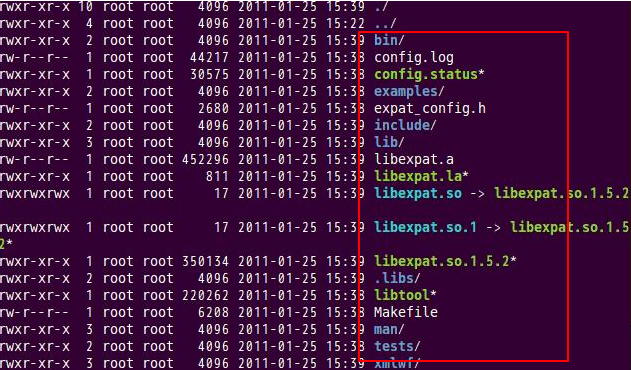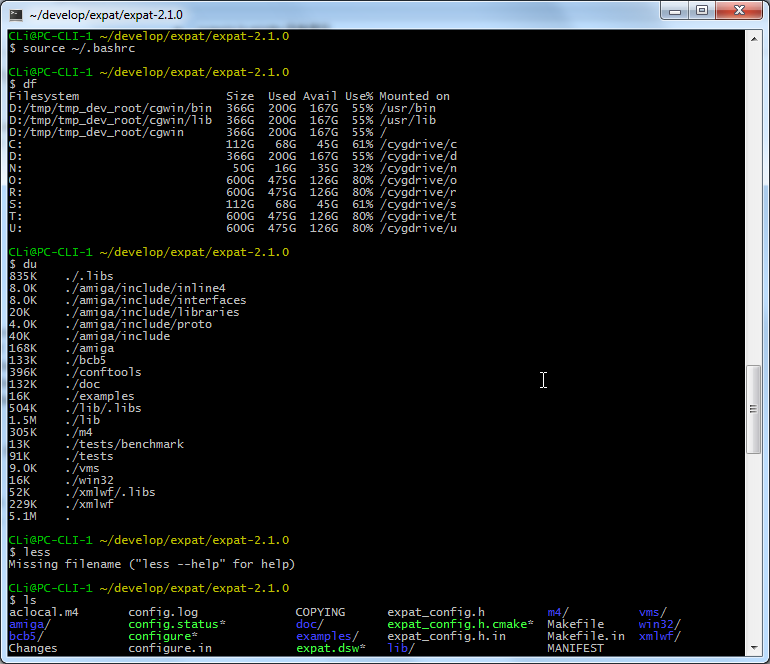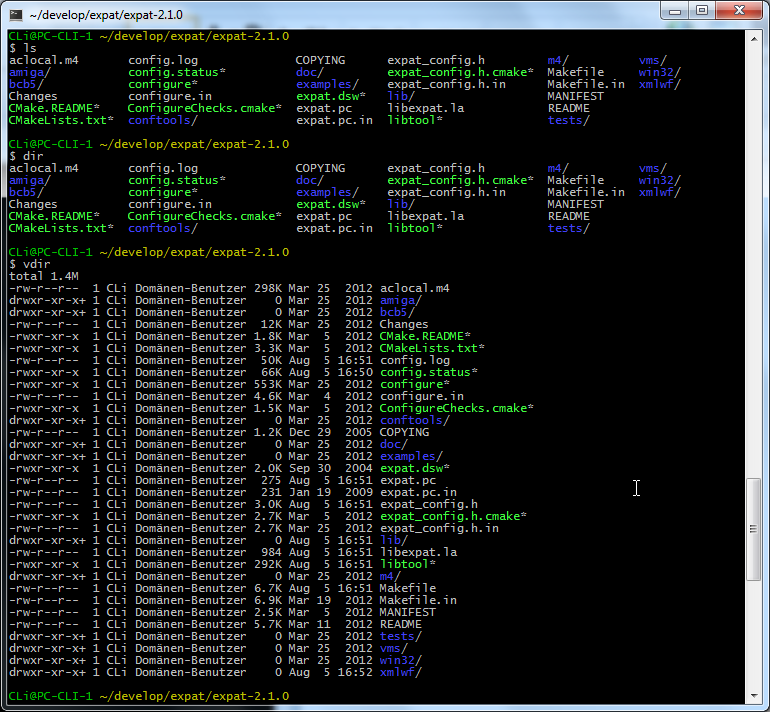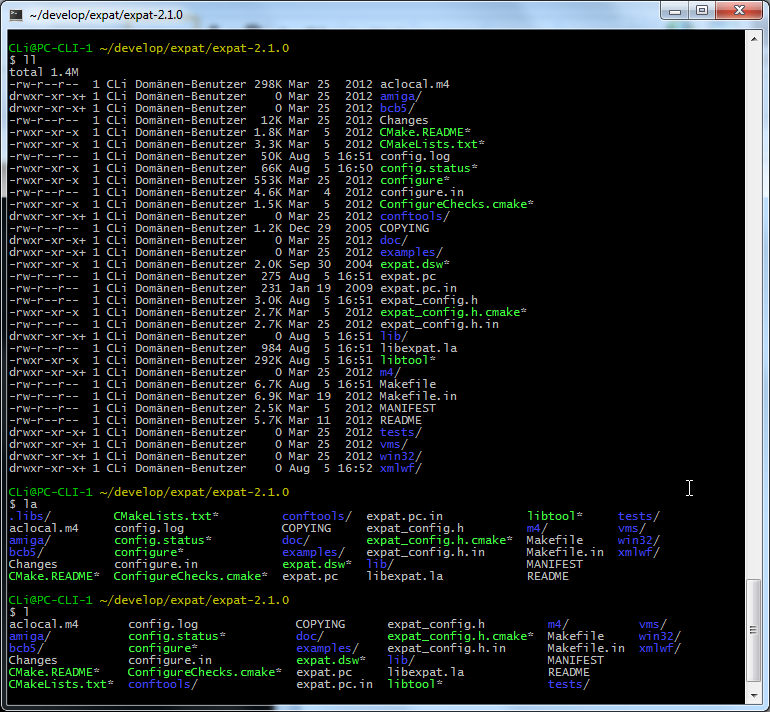【背景】
cygwin,目前用的是mintty。
但是当ls显示出来的文件,不是彩色的:
希望变成,比如这里显示的彩色的这种:
【解决过程】
1.参考:
->
https://github.com/altercation/solarized#screenshots
(有空可以去试试其中的putty等的该颜色配置)
发现是蛮有趣的,但是暂时不需要。
2.参考:
惊艳的cygwin——Windows下的Linux命令行环境的配置和使用
才想起来,貌似输出彩色,是ls输出的,而不是mintty控制的。
所以对于那个ls的–color=tty,去看看,ls本身支持哪些参数:
CLi@PC-CLI-1 ~/develop/expat/expat-2.1.0
$ ls --help
Usage: ls [OPTION]... [FILE]...
List information about the FILEs (the current directory by default).
Sort entries alphabetically if none of -cftuvSUX nor --sort is specified.
Mandatory arguments to long options are mandatory for short options too.
-a, --all do not ignore entries starting with .
-A, --almost-all do not list implied . and ..
--author with -l, print the author of each file
-b, --escape print C-style escapes for nongraphic characters
--block-size=SIZE scale sizes by SIZE before printing them. E.g.,
`--block-size=M' prints sizes in units of
1,048,576 bytes. See SIZE format below.
-B, --ignore-backups do not list implied entries ending with ~
-c with -lt: sort by, and show, ctime (time of last
modification of file status information)
with -l: show ctime and sort by name
otherwise: sort by ctime, newest first
-C list entries by columns
--color[=WHEN] colorize the output. WHEN defaults to `always'
or can be `never' or `auto'. More info below
-d, --directory list directory entries instead of contents,
and do not dereference symbolic links
-D, --dired generate output designed for Emacs' dired mode
-f do not sort, enable -aU, disable -ls --color
-F, --classify append indicator (one of */=>@|) to entries
--file-type likewise, except do not append `*'
--format=WORD across -x, commas -m, horizontal -x, long -l,
single-column -1, verbose -l, vertical -C
--full-time like -l --time-style=full-iso
-g like -l, but do not list owner
--group-directories-first
group directories before files.
augment with a --sort option, but any
use of --sort=none (-U) disables grouping
-G, --no-group in a long listing, don't print group names
-h, --human-readable with -l, print sizes in human readable format
(e.g., 1K 234M 2G)
--si likewise, but use powers of 1000 not 1024
-H, --dereference-command-line
follow symbolic links listed on the command line
--dereference-command-line-symlink-to-dir
follow each command line symbolic link
that points to a directory
--hide=PATTERN do not list implied entries matching shell PATTERN
(overridden by -a or -A)
--indicator-style=WORD append indicator with style WORD to entry names:
none (default), slash (-p),
file-type (--file-type), classify (-F)
-i, --inode print the index number of each file
-I, --ignore=PATTERN do not list implied entries matching shell PATTERN
-k, --kibibytes use 1024-byte blocks
-l use a long listing format
-L, --dereference when showing file information for a symbolic
link, show information for the file the link
references rather than for the link itself
-m fill width with a comma separated list of entries
-n, --numeric-uid-gid like -l, but list numeric user and group IDs
-N, --literal print raw entry names (don't treat e.g. control
characters specially)
-o like -l, but do not list group information
-p, --indicator-style=slash
append / indicator to directories
-q, --hide-control-chars print ? instead of non graphic characters
--show-control-chars show non graphic characters as-is (default
unless program is `ls' and output is a terminal)
-Q, --quote-name enclose entry names in double quotes
--quoting-style=WORD use quoting style WORD for entry names:
literal, locale, shell, shell-always, c, escape
-r, --reverse reverse order while sorting
-R, --recursive list subdirectories recursively
-s, --size print the allocated size of each file, in blocks
-S sort by file size
--sort=WORD sort by WORD instead of name: none -U,
extension -X, size -S, time -t, version -v
--time=WORD with -l, show time as WORD instead of modification
time: atime -u, access -u, use -u, ctime -c,
or status -c; use specified time as sort key
if --sort=time
--time-style=STYLE with -l, show times using style STYLE:
full-iso, long-iso, iso, locale, +FORMAT.
FORMAT is interpreted like `date'; if FORMAT is
FORMAT1<newline>FORMAT2, FORMAT1 applies to
non-recent files and FORMAT2 to recent files;
if STYLE is prefixed with `posix-', STYLE
takes effect only outside the POSIX locale
-t sort by modification time, newest first
-T, --tabsize=COLS assume tab stops at each COLS instead of 8
-u with -lt: sort by, and show, access time
with -l: show access time and sort by name
otherwise: sort by access time
-U do not sort; list entries in directory order
-v natural sort of (version) numbers within text
-w, --width=COLS assume screen width instead of current value
-x list entries by lines instead of by columns
-X sort alphabetically by entry extension
-Z, --context print any SELinux security context of each file
-1 list one file per line
--append-exe append .exe if cygwin magic was needed
--help display this help and exit
--version output version information and exit
SIZE is an integer and optional unit (example: 10M is 10*1024*1024). Units
are K, M, G, T, P, E, Z, Y (powers of 1024) or KB, MB, ... (powers of 1000).
Using color to distinguish file types is disabled both by default and
with --color=never. With --color=auto, ls emits color codes only when
standard output is connected to a terminal. The LS_COLORS environment
variable can change the settings. Use the dircolors command to set it.
Exit status:
0 if OK,
1 if minor problems (e.g., cannot access subdirectory),
2 if serious trouble (e.g., cannot access command-line argument).
Report ls bugs to bug-coreutils@gnu.org
GNU coreutils home page: <http://www.gnu.org/software/coreutils/>
General help using GNU software: <http://www.gnu.org/gethelp/>
For complete documentation, run: info coreutils 'ls invocation'
CLi@PC-CLI-1 ~/develop/expat/expat-2.1.0
$可见,-C==–color,可以指定颜色。
2.但是试了试直接用-C,没效果:
3.所以再去试试其-C=tty,结果也不支持:
4.再试试–color=tty,结果是可以的:
5.所以,去修改自己的.bashrc,但是默认加上此–color=tty参数,还是不加上-h了,-h的话,等需要的话,自己手动输入。
然后才发现,原来对于.bashrc,默认已经帮我们写好了这些配置了:
# Default to human readable figures # alias df='df -h' # alias du='du -h' # # Misc :) # alias less='less -r' # raw control characters # alias whence='type -a' # where, of a sort # alias grep='grep --color' # show differences in colour # alias egrep='egrep --color=auto' # show differences in colour # alias fgrep='fgrep --color=auto' # show differences in colour # # Some shortcuts for different directory listings # alias ls='ls -hF --color=tty' # classify files in colour # alias dir='ls --color=auto --format=vertical' # alias vdir='ls --color=auto --format=long' # alias ll='ls -l' # long list # alias la='ls -A' # all but . and .. # alias l='ls -CF' #
而我们要做的只是:
去掉#,启动即可:
# Default to human readable figures alias df='df -h' alias du='du -h' # # Misc :) alias less='less -r' # raw control characters alias whence='type -a' # where, of a sort alias grep='grep --color' # show differences in colour alias egrep='egrep --color=auto' # show differences in colour alias fgrep='fgrep --color=auto' # show differences in colour # # Some shortcuts for different directory listings alias ls='ls -hF --color=tty' # classify files in colour alias dir='ls --color=auto --format=vertical' alias vdir='ls --color=auto --format=long' alias ll='ls -l' # long list alias la='ls -A' # all but . and .. alias l='ls -CF' #
然后保存一下,再重启cygwin(或者直接用:
source ~/.bashrc
让当前的.bashrc生效。
6.再试试上面的命令的各种效果:
效果还是蛮不错的。
【总结】
在cygwin下,想要让mintty中的ls输出是彩色显示各种文件和文件夹的话,则:
实际上,关于色彩控制,是ls本身内置支持的,而不是mintty控制的。
所以,则可以通过:
ls –color=tty
使得可以在mintty中彩色显示输出。
由此,可以将相应的命令,做成别名alias,放到启动配置文件.bashrc中,而结果发现,实际上,至少是cygwin中,都帮我们默认配置好了这些内容了,然后只需要我们取消注释,启用这些alias即可:
# Default to human readable figures alias df='df -h' alias du='du -h' # # Misc :) alias less='less -r' # raw control characters alias whence='type -a' # where, of a sort alias grep='grep --color' # show differences in colour alias egrep='egrep --color=auto' # show differences in colour alias fgrep='fgrep --color=auto' # show differences in colour # # Some shortcuts for different directory listings alias ls='ls -hF --color=tty' # classify files in colour alias dir='ls --color=auto --format=vertical' alias vdir='ls --color=auto --format=long' alias ll='ls -l' # long list alias la='ls -A' # all but . and .. alias l='ls -CF' #
所以说:
实际上,cygwin中,已经做得不错了,关键在于我们自己会不会用。
转载请注明:在路上 » 【已解决】cygwin中mintty中ls彩色显示文件夹和文件







